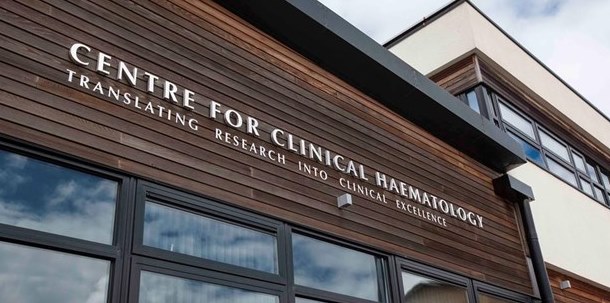The Birmingham Centre for Clinical Haematology oversees one of the most active academic and clinical haematology practices in the world. The centre hosts an internationally competitive early phase clinical trials portfolio. Its mission is to develop and deliver novel drug and transplant therapies in patients with haematological malignancies.
 Professor Charlie Craddock CBE is Academic Director of the Centre for Clinical Haematology.
Professor Charlie Craddock CBE is Academic Director of the Centre for Clinical Haematology.
In 2003 he co-founded the charity Cure Leukaemia with local patients Michael Woolley and Graham Silk, with the aim of allowing blood cancer patients in our region to access the remarkably effective new treatments which were then becoming available.
In 2005, Cure Leukaemia helped secure a grant for £2.2m to build the Centre for Clinical Haematology, which sits at the heart of the BHP campus in Birmingham. This has resulted in the development of the second largest adult stem cell transplant programme in the UK, which was hailed by the then Prime Minister, David Cameron as an international centre of excellence in haemato-oncology.
The impact of the Centre for Clinical Haematology and Cure Leukaemia is closely linked to the unique make-up of the West Midlands region. With a stable and ethnically-diverse population of 5.5m, the region offers access to the broadest possible data pool for drugs trials.
Over the past decade, Cure Leukaemia has funded a network of 15 specialist nurses who work across the Midlands to administer pioneering drug treatments to leukaemia patients.

This combination of the Midlands’ distinct demographic with a network of well-supported nurses have enabled us to leverage millions of pounds worth of pioneering drugs and give patients access to clinical trials for drugs not yet readily available on the NHS.
Many of these trials provide pioneering treatments for patients who have exhausted all other available treatments.
The trials, which have the potential to be practice-changing, cover a range of haematological conditions including leukaemia, lymphoma, myeloma and amyloidosis, as well as rarer conditions.
“What Cure Leukaemia does is it connects patients for whom standard treatments have failed, and for whom the future is otherwise extremely bleak – they’ll be dead, bluntly, within months – with new treatments that perfectly understandably, the NHS won’t fund until clinical trials have been done to show they work.
“So what Cure Leukaemia does is it bridges that gap. It says, we’ve got patients in great need, there’s incredibly promising drugs, let’s put the two together.
“And so in the last ten years, almost entirely through the Cure Leukaemia-funded initiatives and research nurses – not entirely, there’s a coalition of the willing here – but very substantially through Cure Leukaemia’s really pioneering vision, we have been able to recruit hundreds of patients with end-stage disease to clinical trials, many of whom have benefited from what has become £21m worth of free drug.
“That’s drug that patients wouldn’t otherwise have seen. Patients would have died without seeing that drug. And that drug for many hundreds of our patients has delivered long-term remissions or operational cures.
“It is perverse, it is completely wrong, that drugs are sitting on drug companies’ benches, and patients need those drugs, and that just for the want of some funding for research nurses, the two aren’t coming together.
“This is a very radical, innovative and highly effective model.
“The fact is that we still have many patients for whom conventional treatments for blood cancers, particularly adults, fail – who need access to these drugs. We’re turning down clinical trials because we don’t have enough nurses. And so there’s a great unmet need. The more nurses you fund, the more hope you give, and in the long term the more lives you save.”

